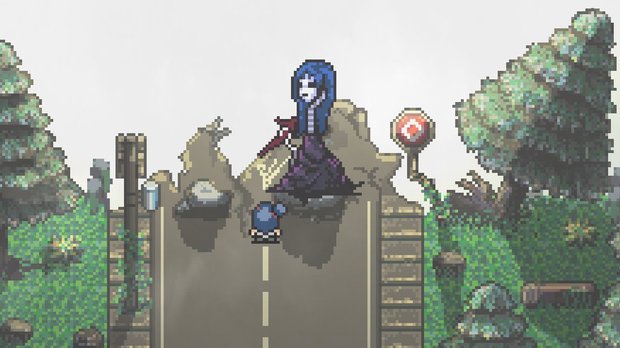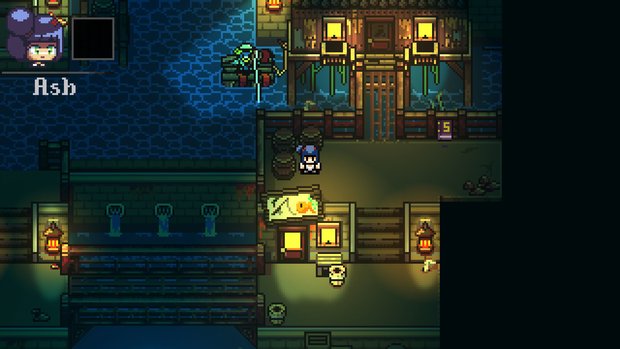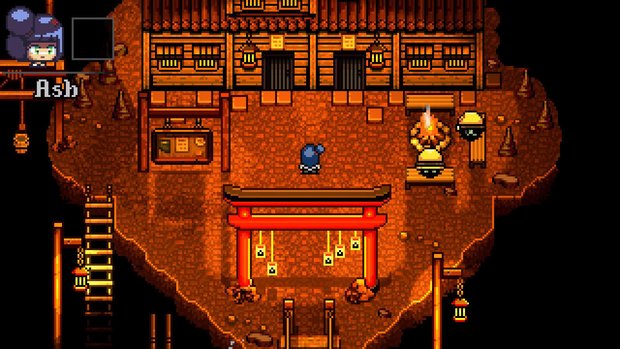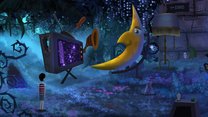Ashina: The Red Witch review – Retro-styled Japanese afterlife adventure lacks depth but conjures up simple charms

- 0 Comments
Contrary to what we see in Disney movies, fairy tales don’t always have happy endings. Stranga’s Ashina: The Red Witch is a retro RPG-styled modern-day fairy tale that pulls heavily from Japanese culture. It tells an interesting supernatural story and backs it up with mostly sensible puzzle design and progression, then ends it all on an abrupt cliffhanger. Making it to that point doesn’t involve much of a commitment, but your enjoyment of the game will largely depend on how much you buy into the game’s overarching fantasy narrative, and how much you can tolerate the game’s relatively straightforward fetch quest-style design.
Ashina tells the story of a young woman named Ash and her sister Tena. The siblings meet at Ash’s apartment one night after work for dinner, where a bit of exposition explains that their mother has passed away and they are the only family each other have left. Ash goes to bed only to awaken later to find a stranger in her apartment, eating her ramen and watching TV. At first Ash mistakes the intruder for a child, but it quickly becomes apparent that this trickster (named Tanto) is not from anywhere around here, but is in fact a spirit from the afterlife. Ash is then whisked away to an alternate dimension where she is at the mercy of Tanto’s sporadic whims while she tries to piece together what is going on and how she can get back home. She soon learns that not only does she have to escape this place by dawn if she wants to return to the world of the living, but her sister is also here somewhere and is bound to the same deadline.
The game does a sound job of settling players into its macabre but equally energetic and comedic premise, though the writing did grate on me for the first little while. Every second word out of Ash’s mouth seems to be *sigh* and it felt at times more like an awkward impression of anime tropes than a developed story of its own. However, as the tale continues, the characters' initially flat personalities become more charming, and I was at least interested, albeit not overly invested, to see what happened next. Tanto’s impulse-driven actions don't get a whole lot of explanation, for example, but his seemingly nonsensical antics do eventually form a plan, and he makes for an entertaining travel companion while it lasts.

The afterlife you’ll explore is like a mirror version of Japan, with a mix of tightly packed urban areas with glowing neon signage, quaint residential blocks, and even temples surrounded by nature. Despite the play time clocking in at only three or so hours, each location in Ashina is fleshed out with its own history and cast of characters living their own (after)lives, and all manner of ghosts and creatures come out of the woodwork to help – or sometimes harm – Ash in her quest. The game can be both beautiful and unnerving at times, with segments in vibrant cities followed by abandoned theatres, cottages, and eerily empty neighbourhoods. A select few occasions, like one where Ash and her sister watch a stage performance, are quite disturbing, though the game certainly leans closer to Spirited Away than Corpse Party, and the horror elements are primarily atmospheric.
The story slowly shifts to focus on Ash and Tena’s mother’s role in the afterlife, though it takes some surprising turns, and how it all ties up (or rather, doesn’t) is genuinely surprising. On that note, Ashina is apparently tied to other games in Stranga’s catalogue, taking place in the same universe and sharing some characters. If, like me, you were unaware of this, the ending makes clear that this is not a standalone story, but up until that point I was under the assumption it would reach some semblance of a conclusion. That’s not to say the game ends poorly; it’s just … sudden and provides no real closure.
Ashina does have multiple endings, however, such as they are. The normal ending is obtained by just finishing the game, but there are alternate takes depending on the amount of side quests and other criteria you complete. From what I understand, the normal ending is considered canon, but if you want to give it subsequent replays, there is some incentive to try out different approaches.

The game looks and controls much like an 8- or 16-bit console-era RPG. In fact, I mistook it for an RPG Maker project at first, though it was in fact made with Adventure Game Studio and crafted to look like a top-down pixel art title from the ground up. I played on PlayStation 5, and you use the D-pad or analog stick to move Ash up, down, left, and right, with dedicated buttons to bring up her inventory and interact with the environment or talk to NPCs. It’s a simple setup that works well, and points of interaction spawn a bit of text at the bottom of the screen, letting you know Ash can interact with them when she is in close proximity.
Ashina is broken into several chapters, each of which takes place in a handful of small areas, though occasionally you’ll have the freedom to travel between places. In one urban setting you explore after emerging from a sewer, for example, you can travel between town, residential, and temple areas by bus. However, even in this instance, the locations are all quite small and you’ll rarely be overwhelmed or lost as to where to go.
Usually Ash will need to obtain an item or find a specific character in order to progress. Each area is segmented into a myriad of fetch quests, some of which are related directly to the story, while others are short diversions revealing more of the larger narrative at play. Ash cannot speak to all of the NPCs, but those she can interact with have several dialogue options, including background details about who and where they are, as well as any pertinent information or errands they may give Ash. One of the first tasks you complete is repairing Tanto’s boombox, for example, which is done by talking to other NPCs who happen to have the parts you need, resulting in several shorter fetch quests in exchange for parts. There’s no quest log telling you what to do, but since there are so few NPCs you can chat with in any given area, if you forget you can simply return to one of them for a reminder as to what you are supposed to be looking for.

There is no real variety to the gameplay. You simply walk between areas/NPCs to deliver goods or information. At one point Ash is tasked with doing the dishes in a sushi restaurant to pay off Tanto’s bill, but even then there is no dishwashing minigame, just Ash cleaning up via an in-game cinematic. This isn’t necessarily a bad thing for an adventure game, but for those hoping for more diversity than ‘Go here, get this. Go there, talk to this guy,’ Ashina may feel a bit plain. When you want to give a character an item or use it on the environment, you simply pull up Ash’s inventory while standing in front of where/who you want to use it with and select the item. You won’t be combining objects via your inventory screen, though you will have to use some together at certain points of interaction in the environment, like mixing chemicals together in a cooking pot.
Ashina utilizes a manual save system at pre-set places. You can record your progress as frequently as you want there, and while you won’t really need to for most of the game, there is a point near the end where you can get a game over. I experienced a minor graphical glitch during this sequence, though fortunately it’s brief and relatively inconsequential.
The graphics emulate a retro aesthetic well, looking and feeling like it could comfortably run on a Sega Genesis or Super Nintendo without pushing the limits of the tech. Expressive character sprites keep things entertaining, though the actual animations for each character are quite limited. I wish some of the set pieces too had been a bit better animated, like the aforementioned theatre scene. And aside from a handful of sequences, Ashina never exploits its horror elements to the fullest. It would have been nice if Stranga has geared the visuals and sound design to match the unnerving setting more. Some of the environments are a bit hard to read as well. Though it never held me back for long, I found myself squinting at the screen occasionally, wondering how/if I could navigate tiered structures.
The music and sound effects suit the game incredibly well. The score in particular stands out, featuring a nice set of tracks with pop-y Asian-themed instrumentals. There is no voice acting for the dialogue, though the occasional line is spoken aloud. Ashina supports text in several languages, and the text speed is adjustable, which is a nice feature, allowing you to click through it at different speeds.
Final Verdict
While Ashina: The Red Witch has a lot to admire, its positives often come with caveats. The gameplay is functional, but very straightforward. Its puzzles are mostly well-telegraphed but quite simple. The story is interesting, but ends in a wholly unsatisfying way. If you are taken by the game’s charm, you’ll probably remain motivated to find out what happens next, but those who aren’t familiar with this universe or don’t feel immersed in the game’s setting may find it a slightly harder sell. Still, it’s a cozy and mostly entertaining experience that can be completed breezily in an afternoon, and as long as you don’t mind giving up control semi-frequently for extended dialogues to play out, it can be kind of fun. It could have been scarier, it could have been prettier, and it could have been more ambitious in its design and gameplay, yet as a short little narrative journey to a Japanese afterlife world, Ashina is ultimately a charming fairy tale that is worth checking out by anyone looking for a laid-back adventure.
Hot take
Ashina: The Red Witch isn't an ambitious game, but as a short and simple retro-styled narrative adventure, it is fun and functional enough for a mild recommendation to those who enjoy this style of anime fantasy.
Pros
- Fetch quest gameplay loop is easy to grasp
- Charming Spirited Away-esque Asian fantasy land
- Optional content and multiple endings offer replay value
Cons
- Overly simplistic puzzles end up being little more than errands
- Implied horror elements aren’t developed as much as they could have been
- Dialogue is uninspired at times
Drew played Ashina: The Red Witch on PlayStation 5 using a review code provided by the game's publisher.

- Advertisement
- Help support AGH by advertising with us











0 Comments
Want to join the discussion? Leave a comment as guest, sign in or register.
Leave a comment